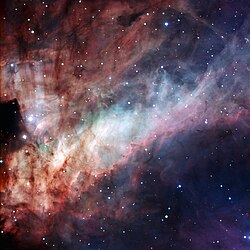ഒമേഗ നെബുല
| ഒമേഗ നെബുല | |
|---|---|
 ഒമേഗ നെബുല, ലാ സിയ്യ നിരീക്ഷണശാല എടുത്ത ചിത്രം. Credit: ESO | |
| Observation data: J2000 epoch | |
| തരം | എമിഷൻ |
| റൈറ്റ് അസൻഷൻ | 18h 20m 26s[1] |
| ഡെക്ലിനേഷൻ | −16° 10′ 36″[1] |
| ദൂരം | 5,000-6,000 ly |
| ദൃശ്യകാന്തിമാനം (V) | +6.0[1] |
| ദൃശ്യവലുപ്പം (V) | 11 ആർക്മിനിറ്റ് |
| നക്ഷത്രരാശി | ധനു |
| ഭൗതികസവിശേഷതകൾ | |
| മറ്റ് നാമങ്ങൾ | ഒമേഗ നെബുല, NGC 6618, Swan Nebula, Sharpless 45, RCW 160, Gum 81 |
| ഇതും കാണുക: ഡിഫ്യൂസ് നെബുല | |
ധനു രാശിയിൽ സ്ഥിതിചെയ്യുന്ന ഒരു H II മേഖലയാണ് ഒമേഗ നെബുല (മെസ്സിയർ 17 - M17) അഥവാ NGC 6618. , സ്വാൻ നെബുല, ചെക്ക്മാർക്ക് നെബുല, ലോബ്സ്റ്റർ നെബുല, ഹോഴ്സ്ഷൂ നെബുല എന്നീ പേരുകളിലും ഇത് അറിയപ്പെടുന്നു. ഫിലിപ്പ് ലോയ് ദി ഷെസോ ആണ് ഇത് കണ്ടെത്തിയത്. ആകാശഗംഗയുടെ നക്ഷത്രസാന്ദ്രതയേറിയ ധനു ഭാഗത്തായാണ് ഇതിന്റെ സ്ഥാനം.
ചരിത്രം
[തിരുത്തുക]1745-ൽ ഫിലിപ്പ് ലോയ് ദി ഷെസോ ആണ് ഈ നീഹാരികയെ ആദ്യമായി നിരീക്ഷിച്ചത്. 1764-ൽ ചാൾസ് മെസ്സിയർ ഇതിനെ നിരീക്ഷിച്ച് തന്റെ പട്ടികയിലെ പതിനേഴാമത്തെ അംഗമായി രേഖപ്പെടുത്തി.
നീഹാരികയുടെ രൂപം കൃത്യമായി വരയ്ക്കാനുള്ള ആദ്യത്തെ ശ്രമം നടത്തിയത് ജോൺ ഹെർഷലായിരുന്നു. 1833-ൽ നടത്തിയ നിരീക്ഷണങ്ങളുടെ ഫലങ്ങൾ 1836-ലാണ് പ്രസിദ്ധീകരിച്ചത്. ഗ്രീക്ക് അക്ഷരമായ ഒമേഗയുടെ (Ω) ആകൃതിയാണ് നീഹാരികക്ക് എന്നദ്ദേഹം നിരീക്ഷിച്ചു.[2] ഇതിനുശേഷം 1837-ൽ ദക്ഷിണാഫ്രിക്കയിലേക്കുള്ള യാത്രയ്ക്കിടെ അദ്ദേഹം ഇതിനെ കൂടുതൽ വിശദമായി നിരീക്ഷിച്ചു. ഈ ഫലങ്ങൾ 1847-ലാണ് പ്രസിദ്ധീകരിക്കപ്പെട്ടത്. ജൊഹാൻ വോൺ ലാമണ്ട്, യേൽ കോളേജിലെ ബിരുദവിദ്യാർത്ഥിയായ മേസൺ എന്നിവരും ഇക്കാലത്ത് നീഹാരികയെ നിരീക്ഷിച്ചിരുന്നു.
1862-ൽ മാൾട്ടയിൽ വച്ച് തന്റെ നാലടി അപ്പെർച്വർ ഉള്ള ദൂരദർശിനി ഉപയോഗിച്ച് വില്യം ലാസൽ ഒമേഗ നെബുല രേഖാചിത്രങ്ങൾ വരച്ചു. ഇതിനുശേഷം കേംബ്രിജിലെ (മസ്സാച്യുസെറ്റ്സ്) എം. ട്രവെലോട്ട്, യുണൈറ്റഡ് സ്റ്റേറ്റ്സ് നേവൽ ഒബ്സർവേറ്ററിയിലെ 26 ഇഞ്ച് ക്ലാർക്ക് റിഫ്രാക്റ്റർ ഉപയോഗിച്ച എഡ്വേഡ് സിംഗിൾട്ടൺ ഹോൾഡൻ എന്നിവരും നീഹാരികയെ നിരീക്ഷിച്ച് ഇതിന്റെ രൂപം രേഖപ്പെടുത്തി.
സവിശേഷതകൾ
[തിരുത്തുക]ഭൂമിയിൽ നിന്ന് ഒമേഗ നെബുലലേക്കുള്ള ദൂരം 5,000-6,000 പ്രകാശവർഷമാണ്. 15 പ്രകാശവർഷമാണ് വ്യാസം, പിണ്ഡം സൂര്യന്റെ 800 ഇരട്ടിയും.[3] 40 പ്രകാശവർഷം വ്യാസവും സൂര്യന്റെ 30,000 ഇരട്ടി പിണ്ഡവുമുള്ള നക്ഷത്രാന്തരീയ മാദ്ധ്യമത്തിന്റെ ഭാഗമാണ് നീഹാരിക.[4] ആകാശഗംഗയിലെ ഏറ്റവും തേജസ്സേറിയതും പിണ്ഡമേറിയതുമായ നക്ഷത്രരൂപവത്കരണമേഖലകളിലൊന്നാണ് M17.[5] ഈ നീഹാരികയുടെ രൂപം ഒറയൺ നെബുലയുടേതിന് സമാനമാണ്, മുഖത്തിനു പകരം വശമാണ് ഭൂമിയിലേക്ക് തിരിഞ്ഞിരിക്കുന്നത് എന്നതാണ് വ്യത്യാസം.[6]
35 നക്ഷത്രങ്ങളടങ്ങിയ ഒരു തുറന്ന താരവ്യൂഹം നീഹാരികയിൽ സ്ഥിതിചെയ്യുന്നു. പ്രായം കുറഞ്ഞതും ചൂടേറിയതുമായ ഈ നക്ഷത്രങ്ങളിൽ നിന്ന് പുറത്തുവരുന്ന വികിരണം പ്രതിഫലിപ്പിച്ച് നീഹാരികയിലെ വാതകം പ്രകാശിക്കുന്നു. നീഹാരികയിൽ ആകെ എണ്ണൂറോളം നക്ഷത്രങ്ങൾ സ്ഥിതിചെയ്യുന്നു, ഇവയിൽ നൂറെണ്ണം B9 സ്പെക്ട്രൽ തരത്തിന് മുമ്പുള്ളവയാണ്, ഒമ്പതെണ്ണം O തരവും.[4] ആയിരത്തിലേറെ നക്ഷത്രങ്ങൾ നീഹാരികയുടെ ബാഹ്യഭാഗങ്ങളിൽ രൂപമെടുത്തുകൊണ്ടിരിക്കുന്നു.[5]. പത്ത് ലക്ഷം വർഷം മാത്രം പ്രായമുള്ള M17 താരവ്യൂഹം അറിയപ്പെടുന്ന ഏറ്റവും ഇളയ താരവ്യൂഹങ്ങളിലൊന്നാണ്.[7]

അവലംബം
[തിരുത്തുക]- ↑ 1.0 1.1 1.2 "SIMBAD Astronomical Database". Results for NGC 6618. Retrieved 2006-11-16.
- ↑ Holden, Edward S. (1876). "The Horseshoe Nebula in Sagittarius". Popular Science. 8: 269–281.
((cite journal)): Unknown parameter|month=ignored (help) - ↑ "Messier 17". SEDS. 2007-08-13. Archived from the original on 1999-04-27. Retrieved 2011-03-09.
- ↑ 4.0 4.1 "Eagle and Omega - Galaxy Map". Retrieved 2012-07-24.
- ↑ 5.0 5.1 Povich, B.L.; Churchwell, E.; Bieging, J.H.; Kang, M.; Whitney, B. A.; Brogan, C.A.; Kulesa, C.A.; Cohen, M.; Babler; Indebetouw, R.; Meade, M.; Robitaille (2009). "The Extended Environment of M17: A Star Formation History". The Astrophysical Journal. 696 (2): 1278–1306. arXiv:0902.3280. Bibcode:2009ApJ...696.1278P. doi:10.1088/0004-637X/696/2/1278.
((cite journal)): More than one of|first1=and|first=specified (help); Unknown parameter|first 12=ignored (|first12=suggested) (help) - ↑ Broos, P. S.; Feigelson, E. D.; Townsley, L.K.; Getman, K.V; Wang, J.; Garmire, G.P.; Jhiang, Z.; Tsuboi, Y. (2007). "The Young Stellar Population in M17 Revealed by Chandra". The Astrophysical Journal Supplement Series. 169 (2): 353–385. arXiv:astro-ph/0612590. Bibcode:2007ApJS..169..353B. doi:10.1086/512068.
- ↑ Hanson, M. M.; Howarth, I.D.; Conti, P.S. (1997). "The Young Massive Stellar Objects of M17". The Astrophysical Journal. 489: 698. Bibcode:1997ApJ...489..698H. doi:10.1086/304808.
നിർദ്ദേശാങ്കങ്ങൾ: ![]() 18h 20m 26s, +16° 10′ 36″
18h 20m 26s, +16° 10′ 36″
Text is available under the CC BY-SA 4.0 license; additional terms may apply.
Images, videos and audio are available under their respective licenses.



